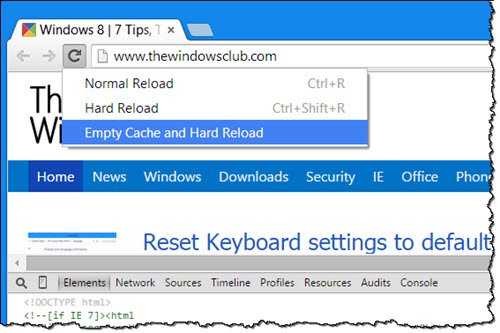Internet penetration across the globe has increased by manifold and continues to follow an upward trend. Web browsers too, have become faster and better at providing a good user experience, primarily by caching the DNS records for a short time on top of the OS level cache. The problem faced by such browsers is when bad results are cached, and this prevents your computer from conveying communication to the host correctly. During such times we normally clear the cache and try again.
Google Chrome browser includes a feature that lets you Normal Reload, Hard Reload or Empty Cache and Hard Reload a web page. This is found in its Developer Tools.
Normal Reload, Empty Cache & Hard Reload features in Chrome
Typically, there are three types of caches in Windows, which you can flush easily – Memory Cache, DNS Cache, and Thumbnails Cache. Clearing the Memory Cache helps free up some system memory while clearing the Thumbnail Cache can free up space in your hard disk. Clearing the DNS Cache fixes your internet connection problem.
In browsers, you typically have Cookies, Temporary Internet Files cache, and Adobe Flash cache. In Chrome, the developer tools help you clear or empty the cache and do a hard refresh and reload easily, without breaking your flow or switching tabs.
When the “Developer Tools” console is open in Google Chrome, the Reload button gets a drop-down menu with some options. Assuming you have the Chrome browser window opened, press F12. This opens the Chrome Developer Tools.
Next, right-click on the browser Reload button visible in the upper right-hand corner of your computer screen. Now, you can find 3 Reload Options displayed:
- Normal Reload: Uses Cached Data
- Hard Reload: Forces browser to re-download items and reload. It is possible that used resources may come from a cached version.
- Empty Cache & Hard Reload: Cache for the page is cleared completely, and everything must be re-downloaded as required.
 When we press F5, a Normal Reload takes place. In this case, if the browser can avoid re-downloading JavaScript files, etc. then it will do so.
When we press F5, a Normal Reload takes place. In this case, if the browser can avoid re-downloading JavaScript files, etc. then it will do so.
In the case of a Hard Reload, the browser does not use anything in the cache and is forced to re-download everything. It is the same as using Ctrl+F5. But if the web page loads additional resources via maybe a redirect, then it may load from the cache. You can also use Ctrl+R or Ctrl+Shift+R.
When you select Empty Cache and Hard Reload, it will empty the cache first and then re-download everything. This is useful if the web page makes after-the-fact downloads via JavaScript that weren’t part of the page load. This is the best option to use if you want to reload a web page completely.
How to do empty cache and hard reload in Chrome?
To empty the cache and hard reload in Chrome, you need to open a website first. Then, press the F12 key to open the Inspect Element section. Next, right-click on the reload button and select the Empty cache and hard reload option. It will do the job for you.
What is hard reload in Chrome?
When you open a website, Chrome downloads several things in the background so that it loads the website quickly. When you use the hard reload option in the browser, it deletes all the pre-downloaded files and re-downloads everything. It is similar to removing the site data, cache, and cookies.
Know more of such simple tips? Share them in the comments section below.
Read next: How to Refresh and Hard Refresh your web page in a browser.
nice thanks
thnx alot